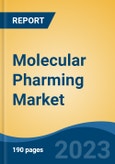Biotechnology & Pharmaceutical Companies is the fastest growing segment, North America is the largest regional market
Speak directly to the analyst to clarify any post sales queries you may have.
10% Free customizationThis report comes with 10% free customization, enabling you to add data that meets your specific business needs.
Key Market Drivers
The Global Molecular Pharming Market is significantly propelled by continuous advancements in genetic engineering technologies. These innovations enable increasingly precise and efficient modification of organisms for pharmaceutical protein production, fostering the development of novel therapeutic compounds and enhancing production yields. For instance, according to Labiotech. eu, September 30, 2025, "CRISPR technology's next wave: Ten companies to watch in 2025", Chroma, a company building an epigenetic editing platform, secured $135 million in Series B funding in 2023, highlighting substantial investment directed towards refining gene-editing capabilities that underpin molecular pharming applications. Such technological progress, including advanced gene-editing tools and synthetic biology techniques, is crucial for overcoming previous limitations in expression levels and product quality, thereby expanding the feasibility and commercial viability of molecular pharming systems across various platforms like plants and microbial hosts.Key Market Challenges
A significant challenge impeding the growth of the Global Molecular Pharming Market is the complex regulatory landscape and the stringent approval processes governing genetically modified organisms and their derived products, along with concerns regarding potential environmental contamination risks. This intricate web of regulations directly impacts market expansion by extending the time required to bring novel biopharmaceuticals to market and increasing associated development costs.The extensive testing, data collection, and sequential regulatory hurdles for genetically modified products, including those produced through molecular pharming, contribute to a prolonged and costly approval pathway. According to EFPIA's 2024 Key Data, an average of 12-13 years elapses from the first synthesis of a new active substance until it reaches the market. This extended timeline delays the commercialization of products and the generation of revenue, thereby diminishing the attractiveness of investing in molecular pharming initiatives. The uncertainty and high capital expenditure linked to navigating these demanding regulatory environments make it more difficult for companies to secure funding and allocate resources to the development of pharming-derived therapeutics, consequently hampering overall market growth.
Key Market Trends
The Global Molecular Pharming Market is experiencing a notable shift due to the diversification of its applications into nutraceutical production. This trend highlights the expansion of molecular pharming beyond traditional pharmaceutical proteins into generating high-value compounds for the functional food and dietary supplement industries. The inherent scalability and cost-effectiveness of molecular pharming platforms, particularly plant-based systems, are well-suited for producing vitamins, antioxidants, and other health-promoting substances, addressing a rising consumer demand for natural and bio-enhanced products. According to the Council for Responsible Nutrition, in 2024, 75% of Americans continued to use dietary supplements, demonstrating sustained consumer interest. This consistent demand propels molecular pharming companies to explore new revenue streams.Key Market Players Profiled:
- Agrenvec S.L
- Diamante SRL
- Leaf Systems International Limited
- Medicago Inc
- Meristem Therapeutics S.A.
- Moolec Science SA
- ORF Genetics
- Pfizer, Inc.
- ProdiGene Inc
- Protalix Biotherapeutics, Inc.
Report Scope:
In this report, the Global Molecular Pharming Market has been segmented into the following categories:By Crop Source:
- Maize
- Barley
- Tobacco
- Safflower
- Rice
- Alfalfa
By Technology:
- Gene Gun
- Agroinfiltration
- Electroporation
- Agrobacterium-Mediated Gene Transfer
- Others
By Application:
- Recombinant Antibodies
- Hormones
- Vaccines
- Industrial Enzymes
- Proteins & Protein-Based Materials
- Technical Reagents
- Nutritional Crop Sources
- Others
By End User:
- Biotechnology & Pharmaceutical Companies
- Contract Manufacturing Organizations
- Others
By Region:
- North America
- Europe
- Asia-Pacific
- South America
- Middle East & Africa
Competitive Landscape
Company Profiles: Detailed analysis of the major companies present in the Global Molecular Pharming Market.Available Customizations:
With the given market data, the publisher offers customizations according to a company's specific needs. The following customization options are available for the report.Company Information
- Detailed analysis and profiling of additional market players (up to five).
This product will be delivered within 1-3 business days.
Table of Contents
Companies Mentioned
The companies profiled in this Molecular Pharming market report include:- Agrenvec S.L
- Diamante SRL
- Leaf Systems International Limited
- Medicago Inc
- Meristem Therapeutics S.A.
- Moolec Science SA
- ORF Genetics
- Pfizer, Inc.
- ProdiGene Inc
- Protalix Biotherapeutics, Inc.
Table Information
| Report Attribute | Details |
|---|---|
| No. of Pages | 180 |
| Published | November 2025 |
| Forecast Period | 2024 - 2030 |
| Estimated Market Value ( USD | $ 2.56 Billion |
| Forecasted Market Value ( USD | $ 4.06 Billion |
| Compound Annual Growth Rate | 8.0% |
| Regions Covered | Global |
| No. of Companies Mentioned | 11 |









